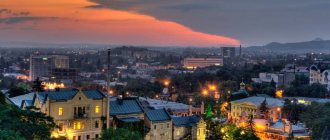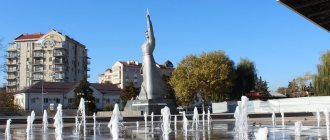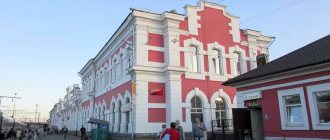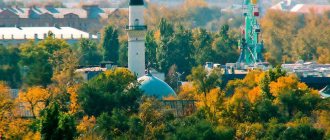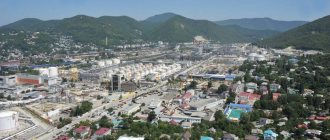Valdai is a land of churches and picturesque nature in the Novgorod region. These lands can safely be called shrines; more than one Orthodox legend was born in the local territories. If you are not so interested in holy places, then the lush pristine nature of Valdai will captivate you. The forests, parks and shores of the Valdai Lakes are especially beautiful in spring and summer, but fans of eco-tourism come here all year round.
Lakes and parks, museums and nature reserves, monasteries, waterfalls - all the interesting things that surround Valdai, in the review of interesting places in the Novgorod region.
Valdai Lake
The first thing that tourists who arrive in Valdai should definitely visit is the lake of the same name, the water area of which stretches for almost 20 kilometers. The average depth is 12 meters, and in some places reaches 60. The reservoir is considered glacial, which indicates its crystal clear water. Ice remains on the water surface from the beginning of winter until May; the lake is popular as a place for fishing, including winter fishing. The pearl of the island is Rowan Island, which can be visited by renting a boat from the locals.
Briefly about Valdai
Valdai is a small city (its area is 61 km², population is more than 14,000 people) in the Novgorod region. It is located on the hill of the same name on the shores of Lake Valdai and is surrounded by coniferous forests. The city is called the cradle of Russian rivers, since it is here that the path of the mighty Volga begins from a small spring, and the Dnieper, Msta, Western Dvina, and tributaries of the Neva originate from small swamps. In the Valdai region there are thousands of streams, springs, including those with healing water, and hundreds of swamps.
Such natural resources make the city a popular tourism center not only in the region, but also in the country. In recent years, many foreign tourists have been coming to Valdai.
Tourists come to Valdai for unique landscapes and unity with nature
The climate in the city is moderate continental, which determines cold and long winters with an average temperature of –10 °C, warm short-term summers (average temperature +17 °C), as well as pronounced spring and autumn with high rainfall.
Valdai is an industrial city where construction, communications, energy, and optical-mechanical devices production enterprises are located.
The distance from Valdai to Moscow is 363 kilometers. The city is in the same time zone as the capital of Russia.
Historical reference
The first mention of Valdai dates back to 1140–1151 and is associated with the peculiarities of taxation of the region, described in the Novgorod birch bark charter of this period.
Valdai has been a separate settlement since 1495 as the Valdai settlement, named after the lake on which it was located.
For some time in the 17th century, the city was a palace village, and in the middle of the 18th century it became part of the Iversky Monastery, located on Lake Valdai, and began to be called Bogoroditsyno.
Since 1770, Valdai became a city, and its favorable location on the route from Moscow to St. Petersburg contributed to its economic and cultural development. The main production in the city was bells of large and small sizes, which were cast by Valdai craftsmen.
Valdai is famous for its large and small bells, which were cast by local craftsmen
With the opening of the Nikolaev railway communication in 1851, the importance of roadside towns began to sharply decrease, which led Valdai to decline.
A new round of history is associated with the first decades of the 20th century. Shortly before the 1917 revolution, a resort with mud and hydrotherapy was opened in the city, which was called Varnitsky. The place immediately became popular among tourists and summer residents who wanted to take a break from the bustle of the city in the lap of nature.
During the Great Patriotic War, partisan and reconnaissance detachments were formed in Valdai, as well as the headquarters of the North-Western Front.
In the post-war years, high party officials liked to relax in Valdai, and even Stalin himself had a dacha there. Years later, almost nothing has changed. Today Valdai is still a favorite destination for summer residents of Moscow and St. Petersburg. On the shore of Lake Valdai there are dachas of A. Chubais, S. Nikonenko, M. Porechenkov. Not far from Valdai, in the area of the village of Dolgiye Borody, there is V.V. Putin’s dacha, where the head of state not only relaxes, but also receives foreign delegations.
According to eyewitness accounts and documents, all Stalin's dachas had the same layout
Table: how to get to Valdai
| Kind of transport | Route | Approximate travel time |
| Airplane | The city does not have its own airport, so you can get to the nearby one in Novgorod, and then take a train or car to Valdai | |
| Train | From Moscow | 5 hours 45 minutes |
From St. Petersburg (via Bologoye):
|
| |
| Bus | From Moscow | 5 o'clock |
| From Saint-Petersburg | 5 hours 30 minutes | |
| Automobile | From Moscow | 5 hours 40 minutes |
| From Saint-Petersburg | 4 hours 30 minutes |
Bell Museum
Address: st. Truda, 2A Telephone: Opening hours: Tue - day off, other days: 10.00 - 18.00 Ticket price: 50 rubles, additional payment for photo and video shooting (100 rubles)
There are only a few museums in the world whose main exhibits are bells. The Valdai Museum became the first such institution in Russia, marking the beginning of interest in such unusual collections. Bells from different years and even eras are presented on the territory not only for viewing, visitors are even allowed to listen to the sound of each individual exhibit.
Nature of Valdai
The entire area of the hill is a natural park. Most of the territory is forested. More than 50 species of different trees, as well as many shrubs and herbs grow throughout the territory.
More than 50 species of different animals also live here. For ornithologists and simply bird lovers, Valdai is a real pearl, since about 180 species of birds live here.
The lakes of Valdai are the basis of the entire Russian fishing industry, they are home to about 50 species of fish, so the waters of the lakes are a real blessing for fishermen and fishing enthusiasts.
In general, the question of what to see in Valdai is not worth it at all, since the territory of the national park is quite vast, and it is very difficult to visit all the places, because the extent of the territories is very large.
In general, Valdai is a large nature reserve and tourist center, which for many years has attracted tourists not only from all over Russia, but also from all over the world. Most tourists know very well where Valdai is located on the map of Russia, because it is a favorite place for nature lovers.
Holy Spring Tekunok
Address: Lake Golova, on the opposite side of the lake from the village of Novotroitsy and the village of Dinner Opening hours: around the clock Website: valdaypark.ru Getting there: leave Valdai along the street. Peschanaya, turn right after the village of Stanki, drive 15 km. to the village of Dinner.
The Tekunok Spring is known for its healing properties. The spring water earned its fame due to the content of silver ions in its composition. The local spring is considered useful not only for the digestive system, but also for the treatment of eye diseases. More recently, a font was built at the source, as well as a consecrated chapel. People come here mainly for physical healing, but in these shrines one can also heal spiritually.
Useful information for tourists
Thanks to its natural conditions, the Valdai Territory is a suitable place for fishermen and hunters.
The following types of fish are caught in numerous rivers and lakes:
- pike;
- bream;
- roach;
- carp;
- lines;
- perches;
- zander;
- rudd.
To hunt, you should contact a hunting farm. An example of this in the Valdai region is the “Hunter’s Shelter” base, located in the village of Klyuchi at house No. 23.
For lovers of extreme recreation, kayaking on local rivers is organized:
- Birch;
- Valdayka;
- Yarynya;
- Msta.
The group is accompanied by an experienced instructor. The cost is 1200 rubles. for an adult and 800 rubles. for a child under 14 years old. The product of the traditional Valdai craft is the bell. To get an individual product, you can stop by the Valdai workshop for the artistic processing of bells at st. Proletarskaya, 22.
Valdai is attractive to tourists with various interests. Connoisseurs of historical monuments come to see its architectural sights, and lovers of quiet or active recreation in nature find here suitable conditions to spend time in accordance with their preferences.
Article design: Oleg Lozinsky
County town museum
Address: st. Lunacharskogo, 7 Telephone: Opening hours: Mon - day off, other days: 10.00 - 18.00 Ticket price: 30 rubles
One of the eras in the development of Valdai is the time when the local region was a royal district. It is this period that all the museum’s exhibitions are dedicated to. The building is divided into five halls, thanks to which visitors can clearly trace the history of the Valdai region, get acquainted with local crafts, ancient things, and even with the Valdai families who lived in the district during the times of Tsarist Russia.
If you are interested in Russian history of this period, be sure to visit and see the sights of Torzhok and Myshkin.
Trinity Cathedral
One of the attractions of the city of Valdai is the Trinity Cathedral, built in 1744 instead of a previously existing wooden church. The building was erected in the Baroque style. In the thirties of the last century, it was prohibited to hold religious services. Ten years later, the complex was partially dismantled, and the inside was later converted into a cultural center. The cathedral is of great value as one of the elements of the Cathedral Square ensemble. Currently, worship has resumed in the temple.
Satan's Lair
Geographic coordinates: N 57° 52.115' E 33° 17.513' get here by personal transport: through Sovetsky Prospekt you get to Zimogorye, take the M10 highway towards St. Petersburg, after 4 kilometers turn left to the Valdai Dvor hotel. After driving 12 kilometers through the forest, turn left, after another 4 km, turn left again (focus on the power lines) - you will come across an abandoned military town, where your journey will begin.
For lovers of extreme sports and unusual entertainment, Valdai has reserved another amazing place. Satan's Lair is an abandoned missile base that was once home to the R-36M, the largest ballistic missile in the world. Today, only ruins remain from its former scale, but they look impressive. Here you can see missile silos and installations, command post buildings and huge hangars. The work of the base was stopped by a powerful explosion, but many buildings survived.
National Park Exhibition
In 2022, a permanent exhibition dedicated to the cultural and natural heritage of Valdai was opened in the visitor center on the territory of the national park. The main goal of a very small museum is to acquaint tourists with the natural features and attractions of the region. Guests are also offered bus and walking routes to explore the world of untouched nature.
The exposition of the establishment consists of interactive screens, imitation of natural objects, and historical objects. The museum covers a fairly large period of history: from the formation of the Alaun Mountains to our time. The exhibition will allow visitors to get acquainted with the Neolithic sites of primitive people, their way of life, economic activities, and the crafts of our distant ancestors. Some of the exhibits are dedicated to the great people of the region, who played a huge role in urban planning and development of the region. In the museum you can also learn about the heroic past of Valdai during the Great Patriotic War.
Iversky Monastery
Address: Iversky Monastery Island, Valdai get there by taxi or from the pier on the motor ship "Zarya-211" Telephone: Opening hours: weekdays from 9.00 to 18.00, Sat-Sun from 13.00 to 17.00, it is advisable to pre-fill a request by phone Website : iveron.ru
The Iversky Monastery belongs to the Orthodox faith and is male. After the troubled times of Rus', this monastery was the very first to be built. The construction dates back to 1653, when small wooden churches were erected on the site of the current building under the leadership of Patriarch Nikon.
The monastery is located on the coast of Lake Valdai in a picturesque natural area, and on its territory are the relics of St. John of Borovichi, and here, in a small chapel in the garden, the Panayev family tomb is founded. The monastery complex also includes a building of fraternal cells, built on 2 floors in the Moscow Baroque style. For a long time, the Iversky Monastery possessed untold wealth, but this era ended with the fall of the tsarist regime.
Quite an interesting video about a road trip around Valdai and its environs:
If you have not yet chosen where you will live and want to save money when booking, we recommend using the RoomGuru service. Firstly, it contains hotels, apartments and guest houses from many different booking systems, so you won’t miss out on a worthwhile option. Secondly, you can immediately compare prices for one place in different services and book where it is cheaper (this is not always Booking!).
History of the region
The history of the city of Valdai is quite unusual. Despite the fact that the city is small, its fame has spread throughout Russia. Valdai is located on the shores of the lake of the same name, thanks to which the village later received its name.
The first mentions of it on birch bark documents are dated 1140-1151. In the Middle Ages, river and land routes through the territory of the Novgorod region ran along the rivers: Shlina, Msta, Polomet and Yavon. It was in these places that centers of crafts and trade gradually appeared.
In 1460-1470, Valdai Selishche consisted of only two courtyards. Already in the fifteenth century, ties between Novgorod and Moscow became stronger, so stations began to be built along the route where travelers rested and changed horses. At the beginning of the sixteenth century, the Road to Novgorod was a slag along the Msta River. And in winter they moved directly on the ice of Lake Valdai. Gradually a land road was built around it. In this regard, the village of Valdai began to gradually expand. By the end of the century, the number of courtyards increased to 94. In the sixteenth century, the Paraskeva Church was already built. Gradually, taverns, taverns and inns began to open in the village. Crafts and trade developed in parallel.
In 1770, by decree of Catherine II, Valdai was given the status of a city. Later it was made Valdai district. The new town had about 2 thousand inhabitants. 50 forges operated here and bell casting began. The streets of the city of Valdai gradually began to acquire new names; they were usually named in honor of some craft (for example, there was Molotkovskaya Street). In 1793, the Church of Catherine was erected.
In 1941, the city of Valdai became famous for its heroism. Active defense made it possible to stop the advance of German troops. The entire history of the city was significantly influenced by its favorable geographical location. And now it has not lost its meaning.

